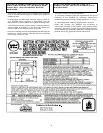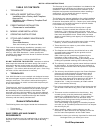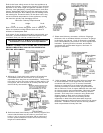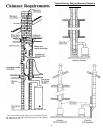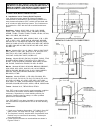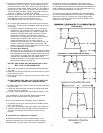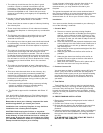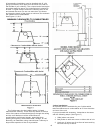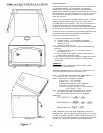3
INSTALLATION INSTRUCTIONS
TABLE OF CONTENTS
I. TECHNOLOGY
II. REPLACE INSERT INSTALLATION
Installation into a Factory-built Fireplace
Approval list
Installation into a Masonry Fireplace Draft
Requirements
III FREESTANDING INSTALLATION
Clearances to combustibles
IV. MOBILE HOME INSTALLATION
V. OPERATING INSTRUCTIONS
VI. STOVE AND CHIMNEY MAINTENANCE
Creosote
Stove Maintenance
Care and cleaning of Woodstove Glass
This manual describes the installation, operation, and
maintenance of the SIERRA Cricket Model 5300 non-
catalytic wood heater. This heater is certified to comply
with July 1992 EPA Standards. Under specific test
conditions, this heater has been shown to deliver the heat
at the following rates:
5300 from 11,000 to 36,400 BTU/hr.
DO NOT OVERFIRE THIS HEATER. Attempts to achieve
heat output that exceeds the heater design can result in
permanent damage to the heater and to the catalytic
combustor. Do not exceed surface temperatures of 800
degrees F. Do not burn with the ash pan open. Over firing
can also void the manufacturer’s warranty.
I. TECHNOLOGY
Your 5300 Cricket is a non-catalytic unit designed to meet
the most stringent emission standards without the use of a
catalytic combustor. This effect is achieved through the
use of a secondary air which is mixed with the primary air
in the unit’s firebox.
The primary air, which is controlled by the user, burns the
wood. Secondary air is admitted into the firebox through
the secondary air tubes at the top of the firebox. This
secondary air burns the impurities in the smoke released
from the initial wood burning. The temperature necessary
for this combustion is maintained through the firebrick
refractory and the heavily insulated box.
General Information
The following items are shipped inside the Ambassador:
• This manual
• Sierra Warranty
BASIC FIREPLACE AND CHIMNEY
REQUIREMENTS
A Sierra woodstove may be installed using an all masonry
fireplace build in accordance with the Uniform Building
Code.
The first step in this type of installation is to determine the
acceptability of the fireplace and chimney for use with a
woodstove. Both the construction and condition of the
fireplace are important considerations when installing a
wood stove. Do not install this stove in a poorly
constructed fireplace or chimney.
The following are general guidelines for a safe installation
and are based on recommendations of the National Fire
Protection Association (NFPA). Contact your local building
code agency or fire safety inspector for specific details.
Local codes may vary by area.
1. The chimney should have a fire clay liner in good
condition. Loose or cracked liner sections can be
hazardous. If the chimney does not have a liner, one
can be installed by a qualified professional. Some metal
liners area acceptable to use. Check with your stove
dealer or local building code agency for acceptability of
these liners.
2. No part of the chimney should have any leaks, missing
masonry, cracks, loose mortar or soft mortar.
3. There should be no mortar or parts of the chimney
blocking the chimney flue.
4. The fireplace and chimney should be built on a solid
concrete footing supported by the ground and not
attached to the house.
Older chimneys are sometimes supported by the
framework of the building itself. These can be
structurally unsound due to settling and shifting of the
building and possible cracking of the chimney itself.
55. The chimney must have a good natural draft and should
be self-starting. A chimney that has poor draft and is
subject to draft reversal should be repaired or replaced
before using..
6. The chimney should be the proper size. Some fireplace
chimneys are quite large and will cause poor stove
performance and excessive creosote. The rule of
thumb is that the chimney flue should be roughly no
more than three times the flue opening on the stove. A
6 inch stove flue will work in an 8 inch by 12 inch
fireplace flue. It may be necessary to install another
liner in an oversized chimney.
7.The chimney should extend at least 3 feet above the roof
and at least 2 feet above any point on the roof within 10
feet.
8. This stove must be used alone in the chimney. Any
unused opening must be permanently sealed with
masonry by a skilled brick mason. A clip-in type flue
liner is not acceptable for this use because of the
possibility of it coming loose during a chimney fire and
possibly causing the fire to spread.
Your local building code agency or fire safety inspector
can refer you to a qualified professional who can inspect
the chimney for you.
9. When installing, make sure the chimney can be
removed to a point lower than the highest point of the
roof for future transportation of the mobile home.
Remember to have your chimney inspected for leaks and
blockage before you install your stove.
Draft Requirements




